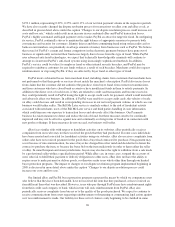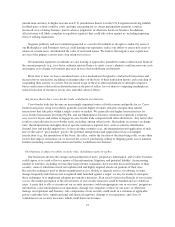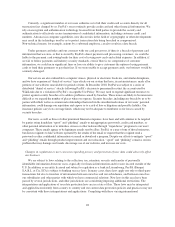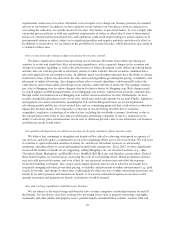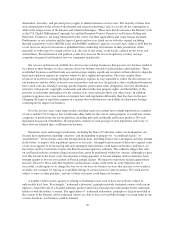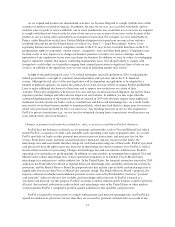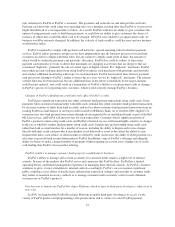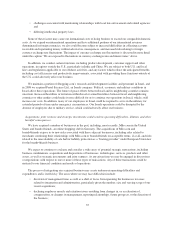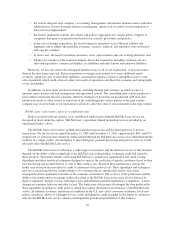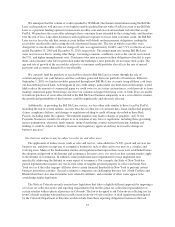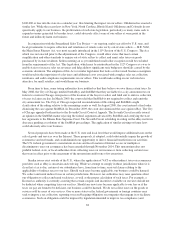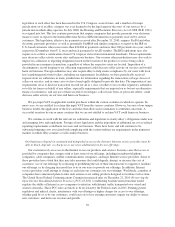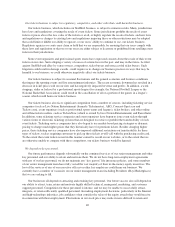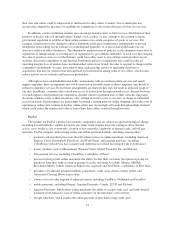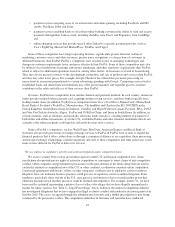eBay 2010 Annual Report Download - page 41
Download and view the complete annual report
Please find page 41 of the 2010 eBay annual report below. You can navigate through the pages in the report by either clicking on the pages listed below, or by using the keyword search tool below to find specific information within the annual report.• the need to integrate each company’s accounting, management, information, human resource and other
administrative systems to permit effective management, and the lack of control if such integration is
delayed or not implemented;
• the need to implement controls, procedures and policies appropriate for a larger public company at
companies that prior to acquisition had lacked such controls, procedures and policies;
• in the case of foreign acquisitions, the need to integrate operations across different cultures and
languages and to address the particular economic, currency, political, and regulatory risks associated
with specific countries;
• in some cases, the need to transition operations, users, and customers onto our existing platforms; and
• liability for activities of the acquired company before the acquisition, including violations of laws,
rules and regulations, commercial disputes, tax liabilities and other known and unknown liabilities.
Moreover, we may not realize the anticipated benefits of any or all of our acquisitions, or may not realize
them in the time frame expected. Future acquisitions or mergers may require us to issue additional equity
securities, spend our cash, or incur debt, liabilities, amortization expenses related to intangible assets or write-
offs of goodwill, which could adversely affect our results of operations and dilute the economic and voting rights
of our stockholders.
In addition, we have made certain investments, including through joint ventures, in which we have a
minority equity interest and lack management and operational control. The controlling joint venture partner in a
joint venture investment may have business interests, strategies or goals that are inconsistent with ours, and
business decisions or other actions or omissions of the controlling joint venture partner or the joint venture
company may result in harm to our reputation or adversely affect the value of our investment in the joint venture.
Bill Me Later’s operations expose us to additional risks.
Risks associated with our reliance on an unaffiliated lender in providing the Bill Me Later service are
discussed in detail under the caption “Bill Me Later’s operations depend on lending services provided by an
unaffiliated lender” above.
The Bill Me Later service relies on third-party merchant processors and payment gateways to process
transactions. For the fiscal year ended December 31, 2009 and December 31, 2010, approximately 80% and 67%,
respectively, of all transaction volume by dollar amount through the Bill Me Later service was settled through the
facilities of a single vendor. Any disruption to these third party payment processing and gateway services would
adversely affect the Bill Me Later service.
The Bill Me Later service is offered to a wide range of consumers, and the financial success of this business
depends on the ability of the issuing bank of the Bill Me Later credit products to manage credit risk related to
those products. The lender extends credit using Bill Me Later’s proprietary segmentation and credit scoring
algorithms and other analytical techniques designed to analyze the credit risk of specific customers based on their
past purchasing and payment history as well as their credit scores. Based on these performance criteria, the
lender may extend or increase lines of credit to consumers at the point of sale. These algorithms and techniques
may not accurately predict the creditworthiness of a consumer due to, among other factors, inaccurate
assumptions about a particular consumer or the economic environment. The accuracy of the predictions and the
ability of the lender and us to manage credit risk related to the Bill Me Later service may also be affected by
legal or regulatory changes (such as bankruptcy laws and minimum payment regulations), competitors’ actions,
changes in consumer behavior and other factors. The lender may also incorrectly interpret the data produced by
these algorithms in setting its credit policies, which may impact the financial performance of the Bill Me Later
service. In addition, economic and financial conditions in the U.S. may affect consumer confidence levels and
reduce consumers’ ability or willingness to use credit, including the credit extended by the lender to consumers
who use the Bill Me Later service, which could impair the growth and profitability of this business.
36


